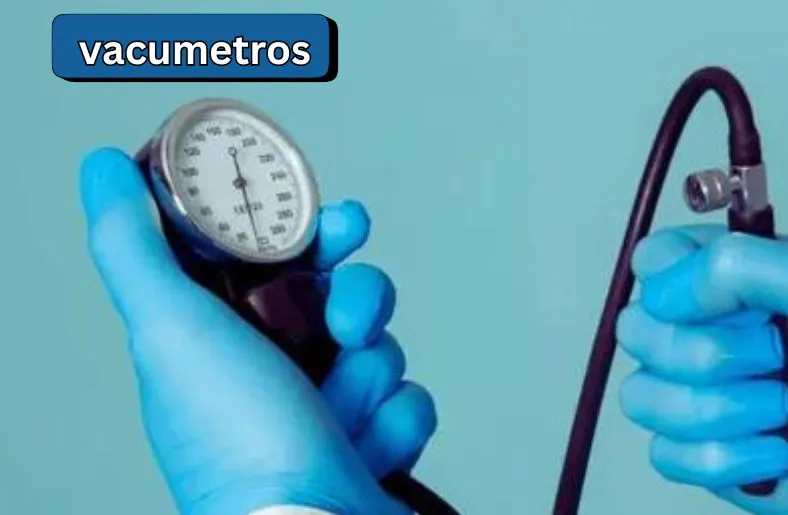Introduction
Vacumetros are vital tools used to measure vacuum pressure in different settings. Whether in factories, labs, or homes, these devices play a crucial role. They help us understand how strong or weak a vacuum is in a system. Without them, many processes wouldn’t work correctly.
Imagine trying to bake a cake in space. You’d need to know exactly how much air is in the oven. That’s where vacumetros come in. They ensure the right vacuum levels, so everything runs smoothly.
In this article, we will explore what vacumetros are and why they are important. We’ll look at different types of vacumetros and their uses. By the end, you’ll see how these simple yet powerful tools help in everyday tasks and advanced technologies.
Types of Vacumetros
Vacumetros come in different types, each designed for specific needs. Understanding these types helps in choosing the right one for your task.
First, there are mechanical vacumetros. These include Bourdon tube gauges and diaphragm gauges. Bourdon tube gauges use a coiled tube that straightens when pressure changes. They are strong and handle higher vacuum levels well. Diaphragm gauges have a flexible diaphragm that bends under pressure. They are more sensitive and measure lower pressures accurately.
Next, we have thermal conductivity vacumetros. These gauges measure pressure by checking how heat moves through the gas. Pirani gauges use a heated filament to see how much heat is lost. The change in temperature tells us the pressure. They are good for medium to high vacuum levels. Thermocouple gauges use a thermocouple to measure the filament’s temperature. The voltage changes with pressure, giving accurate readings.
Another type is ionization vacumetros. These measure pressure by ionizing the gas and detecting the current produced. Penning gauges use a cold cathode to ionize the gas. The amount of ion current tells us the pressure. They are ideal for very high vacuum levels. Bayard-Alpert gauges use a hot filament to ionize the gas. The collected ion current measures ultra-high vacuum levels accurately.
In summary, choosing the right vacumetro depends on what you need. Mechanical vacumetros are simple and durable. Thermal conductivity vacumetros offer precise readings for medium to high vacuums. Ionization vacumetros are best for very high or ultra-high vacuums. Each type has unique features to meet different needs.
How Vacumetros Work
Vacumetros measure vacuum pressure by detecting the difference between the inside of a system and the outside atmosphere. Here’s how they work:
Mechanical vacumetros use physical parts to measure pressure. For example, Bourdon tube gauges have a coiled tube that straightens when pressure changes. This movement is then shown on a dial. Diaphragm gauges have a flexible membrane that bends under pressure, and the amount it bends tells the pressure level.
Thermal conductivity vacumetros measure how heat moves through the gas. In a Pirani gauge, a heated filament loses heat to the gas. The amount of heat lost depends on the gas pressure. Similarly, a Thermocouple gauge uses a thermocouple to check the filament’s temperature. The voltage generated by the thermocouple changes with the gas pressure.
Ionization vacumetros work differently. They ionize the gas inside the vacuum. In Penning gauges, a cold cathode creates ions, and the current of these ions shows the pressure. Bayard-Alpert gauges use a hot filament for ionization. The collected ion current helps measure ultra-high vacuum levels accurately.
Each type of vacumetro has its own way of measuring, but all ensure precise readings for different vacuum conditions.
Applications of Vacumetros
Vacumetros are used in many areas to ensure processes run smoothly. In scientific research, they are vital for experiments needing precise vacuum conditions. Scientists use them in vacuum chambers to study particles and chemical reactions.
In semiconductor manufacturing, vacumetros control vacuum levels during production. This helps create high-quality chips with fewer defects. Similarly, in vacuum coating, vacumetros monitor pressure to ensure thin films are applied evenly. This is crucial for producing consistent coatings.
The food industry also relies on vacumetros for packaging. They help remove air from packages, extending shelf life and keeping food fresh. In medical fields, vacumetros ensure proper vacuum levels for wound closure and sterilization processes. Accurate measurements are essential for patient safety and equipment reliability.
Vacumetros are important in vacuum metallurgy too. They ensure metals are melted and cast under the right vacuum conditions. This prevents contamination and results in high-purity alloys. In space simulation, vacumetros create and maintain vacuum conditions similar to outer space. This allows for testing of spacecraft parts and materials.
Lastly, in refrigeration and HVAC systems, vacumetros help maintain the right vacuum levels during installation and maintenance. This prevents air and moisture from entering the system, which keeps it running efficiently.
Overall, vacumetros are essential in many industries, helping maintain quality, safety, and efficiency.
Benefits of Using Vacumetros
Vacumetros offer several important benefits. First, they provide precise measurements of vacuum levels. This accuracy ensures that systems operate correctly and efficiently.
For example, in manufacturing, precise vacuum levels prevent defects and improve product quality. In scientific research, accurate readings are crucial for reliable experiments.
Another benefit is the reduction in costs. By optimizing vacuum levels, vacumetros help avoid energy waste and minimize material loss. This leads to savings and more efficient processes.
Additionally, vacumetros contribute to safety. They help monitor and maintain safe vacuum conditions, preventing dangerous situations. For instance, in medical applications, correct vacuum levels are vital for safe procedures.
Vacumetros also enhance productivity. They allow for real-time monitoring, so adjustments can be made quickly. This helps keep operations running smoothly without interruptions.
Overall, vacumetros are valuable tools. They improve accuracy, save costs, ensure safety, and boost productivity. Their role in maintaining optimal vacuum conditions makes them essential in many fields.
Choosing the Right Vacumetro
Choosing the right vacumetro is crucial for accurate measurements. Start by considering the pressure range you need. Different vacumetros measure different vacuum levels, so pick one that fits your specific range.
Next, think about accuracy. For critical applications, like semiconductor manufacturing, high precision is essential. Ensure the vacumetro you select meets these accuracy requirements.
Consider the operating environment. If you work in harsh conditions, choose a durable vacumetro. Some models are designed to withstand extreme temperatures or corrosive environments.
Also, look at ease of use. User-friendly controls and clear displays can make operating the vacumetro simpler. This helps avoid errors and ensures reliable measurements.
Another factor is maintenance. Some vacumetros require regular calibration and upkeep. Opt for models that are easy to maintain and calibrate to save time and effort.
Lastly, budget is important. Higher precision and durability might cost more, but they are worth the investment for critical applications. Balance your needs with your budget to find the best vacumetro.
By considering these factors, you can select a vacumetro that fits your needs perfectly. This ensures accurate measurements and smooth operations in your applications.
Maintenance and Calibration
Maintaining and calibrating your vacumetro is essential for accurate measurements. First, regularly check for signs of wear and tear. Inspect connections and components to ensure everything is in good condition.
Next, clean the vacumetro according to the manufacturer’s guidelines. Dust and debris can affect accuracy. Use appropriate cleaning tools to avoid damaging the device.
Calibration is also crucial. It ensures your vacumetro gives correct readings. Follow the manufacturer’s instructions for calibration procedures. Regular calibration helps maintain accuracy over time.
Additionally, keep a record of all maintenance and calibration activities. This helps track performance and identify any issues early.
By performing regular maintenance and calibration, you ensure your vacumetro works reliably. This keeps your measurements accurate and your processes running smoothly.
Future Trends in Vacumetro Technology
Future trends in vacumetro technology promise exciting advancements. First, digital vacumetros are becoming more popular. They offer higher accuracy and easier readability compared to traditional models.
Next, wireless connectivity is a growing trend. It allows remote monitoring and control of vacumetros. This makes managing systems more convenient and efficient.
Moreover, new materials are being used in vacumetro construction. These materials are more durable and resistant to harsh conditions. They ensure longer-lasting and reliable performance.
Additionally, vacumetros are increasingly integrating with automated systems. This integration allows real-time adjustments based on vacuum measurements. It enhances precision and efficiency in various processes.
Overall, these advancements will make vacumetros more accurate and user-friendly. They will continue to play a crucial role in industries that rely on precise vacuum measurements.
Safety Considerations
When using vacumetros, safety is crucial. First, always follow the manufacturer’s guidelines for operation. This helps prevent accidents and ensures accurate readings.
Next, wear appropriate protective gear. Safety goggles and gloves can protect you from potential hazards, such as broken glass or chemicals.
Additionally, ensure proper ventilation in the work area. Good airflow reduces the risk of harmful gas buildup, which can be dangerous.
Moreover, regularly inspect vacumetros for any signs of damage. Cracks or leaks can affect performance and pose safety risks.
Finally, be aware of the vacuum system’s pressure limits. Exceeding these limits can cause equipment failure or accidents. Always use vacumetros within their specified range.
By following these safety tips, you can ensure a safe working environment and effective use of vacumetros.
Conclusion
In conclusion, vacumetros are essential tools for accurate vacuum measurement across various industries. They come in different types, each suited for specific needs, from mechanical to ionization vacumetros. Understanding how they work and choosing the right one ensures precise and reliable results. Their applications span from scientific research to manufacturing, improving product quality and operational efficiency. Proper maintenance and calibration are crucial for optimal performance, while safety considerations cannot be overlooked. As technology evolves, future trends promise even more advanced and user-friendly vacumetros. Embracing these innovations will continue to enhance their effectiveness and impact.





